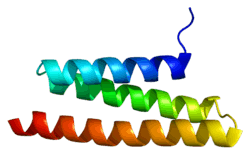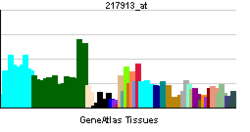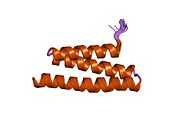VPS4A
Vacuolar protein sorting-associated protein 4A is a protein that in humans is encoded by the VPS4A gene.[1][2][3]
Function
The protein encoded by this gene is a member of the AAA protein family (ATPases associated with diverse cellular activities), and is the homolog of the yeast Vps4 protein. In humans, two paralogs of the yeast protein have been identified. The former share a high degree of aa sequence similarity with each other, and also with yeast Vps4 and mouse Skd1 proteins. The mouse Skd1 (suppressor of K+ transport defect 1) has been shown to be really a yeast Vps4 ortholog. Functional studies indicate that both human paralogs associate with the endosomal compartments, and are involved in intracellular protein trafficking, similar to Vps4 protein in yeast. The gene encoding this paralog has been mapped to chromosome 16; the gene for the other resides on chromosome 18.[3]
Interactions
VPS4A has been shown to interact with CHMP1A.[4]
References
- ↑ Bishop N, Woodman P (April 2000). "ATPase-defective Mammalian VPS4 Localizes to Aberrant Endosomes and Impairs Cholesterol Trafficking". Mol Biol Cell 11 (1): 227–39. doi:10.1091/mbc.11.1.227. PMC 14770. PMID 10637304.
- ↑ Scheuring S, Röhricht RA, Schöning-Burkhardt B, Beyer A, Müller S, Abts HF et al. (September 2001). "Mammalian cells express two VPS4 proteins both of which are involved in intracellular protein trafficking". J Mol Biol 312 (3): 469–80. doi:10.1006/jmbi.2001.4917. PMID 11563910. Vancouver style error (help)
- ↑ 3.0 3.1 "Entrez Gene: VPS4A vacuolar protein sorting 4 homolog A (S. cerevisiae)".
- ↑ Howard TL, Stauffer DR, Degnin CR, Hollenberg SM (July 2001). "CHMP1 functions as a member of a newly defined family of vesicle trafficking proteins". J. Cell. Sci. 114 (Pt 13): 2395–404. PMID 11559748.
Further reading
- Scheuring S, Bodor O, Röhricht RA, Müller S, Beyer A, Köhrer K (1999). "Cloning, characterisation, and functional expression of the Mus musculus SKD1 gene in yeast demonstrates that the mouse SKD1 and the yeast VPS4 genes are orthologues and involved in intracellular protein trafficking". Gene 234 (1): 149–59. doi:10.1016/S0378-1119(99)00163-8. PMID 10393249. Vancouver style error (help)
- Hu RM, Han ZG, Song HD, Peng YD, Huang QH, Ren SX et al. (2000). "Gene expression profiling in the human hypothalamus-pituitary-adrenal axis and full-length cDNA cloning". Proc. Natl. Acad. Sci. U.S.A. 97 (17): 9543–8. doi:10.1073/pnas.160270997. PMC 16901. PMID 10931946.
- Howard TL, Stauffer DR, Degnin CR, Hollenberg SM (2002). "CHMP1 functions as a member of a newly defined family of vesicle trafficking proteins". J. Cell. Sci. 114 (Pt 13): 2395–404. PMID 11559748.
- Tanaka H, Fujita H, Katoh H, Mori K, Negishi M (2002). "Vps4-A (vacuolar protein sorting 4-A) is a binding partner for a novel Rho family GTPase, Rnd2". Biochem. J. 365 (Pt 2): 349–53. doi:10.1042/BJ20020062. PMC 1222680. PMID 11931639.
- Nara A, Mizushima N, Yamamoto A, Kabeya Y, Ohsumi Y, Yoshimori T (2002). "SKD1 AAA ATPase-dependent endosomal transport is involved in autolysosome formation". Cell Struct. Funct. 27 (1): 29–37. doi:10.1247/csf.27.29. PMID 11937716.
- Chagnon P, Michaud J, Mitchell G, Mercier J, Marion JF, Drouin E et al. (2003). "A Missense Mutation (R565W) in Cirhin (FLJ14728) in North American Indian Childhood Cirrhosis". Am. J. Hum. Genet. 71 (6): 1443–9. doi:10.1086/344580. PMC 378590. PMID 12417987.
- Beyer A, Scheuring S, Müller S, Mincheva A, Lichter P, Köhrer K (2003). "Comparative sequence and expression analyses of four mammalian VPS4 genes". Gene 305 (1): 47–59. doi:10.1016/S0378-1119(02)01205-2. PMID 12594041. Vancouver style error (help)
- Katoh K, Shibata H, Suzuki H, Nara A, Ishidoh K, Kominami E et al. (2003). "The ALG-2-interacting protein Alix associates with CHMP4b, a human homologue of yeast Snf7 that is involved in multivesicular body sorting". J. Biol. Chem. 278 (40): 39104–13. doi:10.1074/jbc.M301604200. PMID 12860994.
- Strack B, Calistri A, Craig S, Popova E, Göttlinger HG (2003). "AIP1/ALIX is a binding partner for HIV-1 p6 and EIAV p9 functioning in virus budding". Cell 114 (6): 689–99. doi:10.1016/S0092-8674(03)00653-6. PMID 14505569. Vancouver style error (help)
- von Schwedler UK, Stuchell M, Müller B, Ward DM, Chung HY, Morita E et al. (2003). "The protein network of HIV budding". Cell 114 (6): 701–13. doi:10.1016/S0092-8674(03)00714-1. PMID 14505570. Vancouver style error (help)
- Sachse M, Strous GJ, Klumperman J (2004). "ATPase-deficient hVPS4 impairs formation of internal endosomal vesicles and stabilizes bilayered clathrin coats on endosomal vacuoles". J. Cell. Sci. 117 (Pt 9): 1699–708. doi:10.1242/jcs.00998. PMID 15075231.
- Lin Y, Kimpler LA, Naismith TV, Lauer JM, Hanson PI (2005). "Interaction of the mammalian endosomal sorting complex required for transport (ESCRT) III protein hSnf7-1 with itself, membranes, and the AAA+ ATPase SKD1". J. Biol. Chem. 280 (13): 12799–809. doi:10.1074/jbc.M413968200. PMID 15632132.
- Scott A, Gaspar J, Stuchell-Brereton MD, Alam SL, Skalicky JJ, Sundquist WI (2005). "Structure and ESCRT-III protein interactions of the MIT domain of human VPS4A". Proc. Natl. Acad. Sci. U.S.A. 102 (39): 13813–8. doi:10.1073/pnas.0502165102. PMC 1236530. PMID 16174732.
- Tsang HT, Connell JW, Brown SE, Thompson A, Reid E, Sanderson CM (2006). "A systematic analysis of human CHMP protein interactions: additional MIT domain-containing proteins bind to multiple components of the human ESCRT III complex". Genomics 88 (3): 333–46. doi:10.1016/j.ygeno.2006.04.003. PMID 16730941.
- Chen VY, Posada MM, Blazer LL, Zhao T, Rosania GR (2007). "The role of the VPS4A-exosome pathway in the intrinsic egress route of a DNA-binding anticancer drug". Pharm. Res. 23 (8): 1687–95. doi:10.1007/s11095-006-9043-0. PMID 16841193.
- Lambert C, Döring T, Prange R (2007). "Hepatitis B Virus Maturation Is Sensitive to Functional Inhibition of ESCRT-III, Vps4, and γ2-Adaptin". J. Virol. 81 (17): 9050–60. doi:10.1128/JVI.00479-07. PMC 1951427. PMID 17553870. Vancouver style error (help)
| |||||||||


